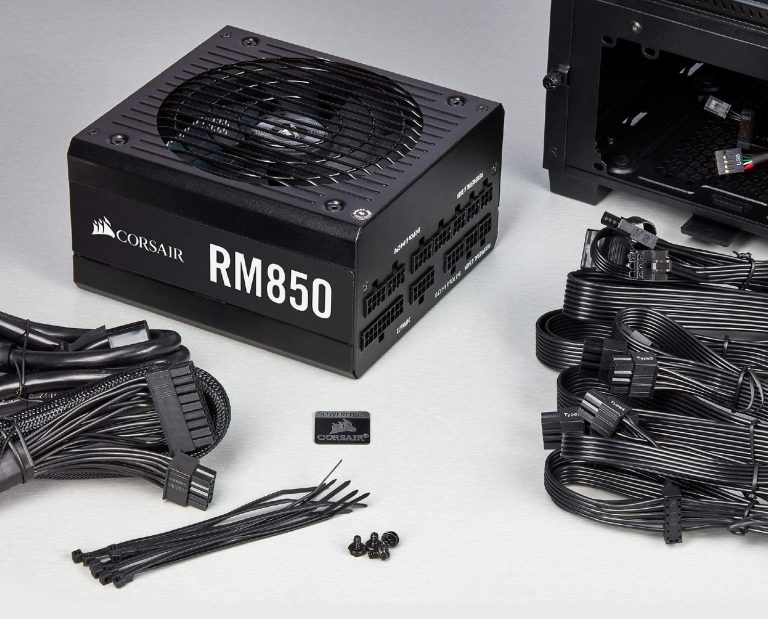
The power supply unit (PSU) is an electronic device that causes a lot of confusion and difficulties for users, because it is really difficult to measure and evaluate its performance. use. Basically, power supplies can't see the performance when used like other components, not to mention really, most power supplies on the market don't have much improvement in the aesthetics of a computer system. . But, the truth is, power supplies have a huge impact on a computer system.

If the user chooses a bad power supply, the system will not be able to run smoothly, even after a short time, many components inside the system will go away and the culprit for this is the power supply. On the other hand, most users will not understand which power supply they need to be able to run the system they are using effectively.
So, in today's article, we'll discuss some factors to consider when choosing a power supply. These factors are the main points of reference so that people can choose a power supply that is right for their individual needs and finances. This article is ver 2.0 improved and added new knowledge compared to ver 1.0 that I posted and was sticky on vOz forum in 2015.
I. Why is PSU needed?
The power supply is a prerequisite for the launch of the PC system. Because it is the heart of the PC system, the damage when it crashes or fails is huge. Because the main power supply is one of the causes of problems for the PC system or causing the components inside it to die or reduce its lifespan. It is also the key to stable operation in the end, so keep these three points in mind. The more expensive the system, the more stable it is, the more serious it is to invest in a good power supply.
II. Buying a PSU need to rely on the wattage on the label?
An example you will see:
Below is the power table of the AMD R9 290's minimum PSU requirement of 600W for a real power source. But in reality, there will be 2 cases:

- The PSU has good quality components, the power level is smaller than recommended, but still ABLE to load the configuration with the R9 290, including overclocking. For example, Cooler Master G550M…
- PSU labeled 600W, although it is real power, the quality of components is not high, 12V line for low power. Long-term running affects the quality and stability of other components such as VGA, HDD, Main ...
There are many brands that write the nominal power on the PSU label that always exceeds the level that the PSU works, this is a way to follow it that is not fairplay or a PR trick. So how to choose a PSU that suits you both in terms of needs and budget among the numerous PSUs available on the market?
II. How do we choose a power supply when there is not much product knowledge?
1. Nominal power (also known as actual power, rated power) of a source product means the maximum power that a power supply can stably supply. A 500W power supply can run a system that consumes less than or equal to 500W. However, what we need to pay attention to here is that the capacity should not be chosen exactly to the power consumption used by the system. What is the reason for this?
For those new to power supplies, the safe bet is to choose a power supply that's 1.5 or even 2 times more powerful than the system can handle. At this point, you will wonder why you have to choose that? The answer continues to be very simple, because firstly, the PSU has a wear factor, the more it works, the higher the wear factor will increase, the capacity used will decrease after many years of use.
As you can see, the more overused a power supply is when running close to the capacity it can provide, the higher the operating temperature is at this time. The heat caused when the power supply is operating at this time is a silent killer and causes many problems as follows:
- An increase in temperature is especially harmful to the life of capacitors and internal components. If the operating temperature rises too high, the fan will rotate 100%, causing loud noise.
- Power supplies operate up to 100% of their heavy load, lower energy efficiency, causing more energy loss.
- If the operating temperature increases by 10 degrees, the expected life of the capacitor is halved. Conversely, if it drops by 10 degrees, the expected life will double. Here's a simple equation that we've also learned, refer to the Arrhenius equation . This means that if the temperature is only 10 degrees higher, it means that the life of the capacitor, which should have been 10 years, is reduced to 5 years.
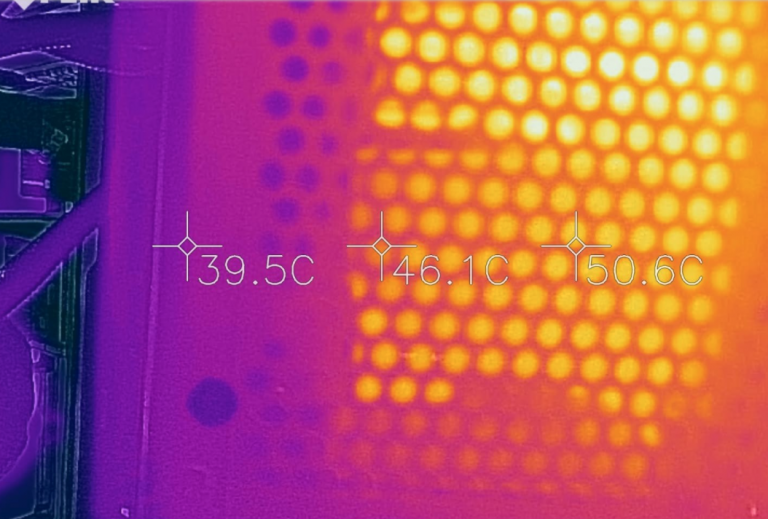
Assuming your system consumes about 400W, you can choose a power supply with a capacity of 600W or even 800W. However, if the budget does not allow, we can choose at 1.2 or 1.5 times, that is, we can choose a PSU with a capacity of 500W or 600W for long-term use. However, the choice of a PSU with a capacity of 2 times the actual use capacity, usually applies to systems and PSUs with a power level of 1600W.
2. Use the tool to calculate the used capacity of the existing system
With a little more knowledge, it is possible to determine how many W of power the system uses to choose a power supply. To do this, the simplest way is to go to google and type keywords in English as follows: Power supply calculator.
At this time, the keyword will return a series of results, most of which are websites of famous PSU manufacturers, people can click on any of the links returned from the results on page 1. to be able to check how much your system will need a PSU based on the number returned after performing the calculation steps from the tools.
However, according to practical experience, the OuterVision Website is first in the search list: https://outervision.com/power-supply-calculator will be the Website I recommend everyone to use, because it has accuracy. and more customizable. OuterVision is quite a useful Web site so that it is easier and less time consuming for anyone to determine how much consumption the system will actually need. This level is the level of residual power so that everyone can feel secure because in practice using the power supply has the same wear factor as mentioned above. It's also simple to do, just select the drop-down menus provided and enter the relevant components in the system and then press the calculate button to see the suggested PSU capacity for the system, from basic to to overclocking.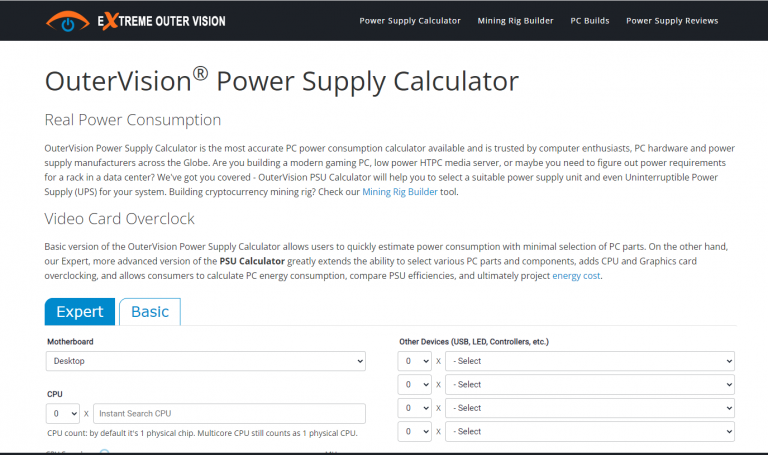
3. Based on the recommended list of available power supplies recommended by experts.
Currently, PSUs are classified into 5 rankings, commensurate with the quality and design of the PSU:
- Tier 1 (Excellent): The best quality PSU, providing the most complete power, very very excellent, and suitable for high overclocks, ultra-high-end systems, and even for power Show it off to the world. The Tier 1 PSU series can be summed up in one sentence: The best of the best.
- Tier 2a (good): A PSU that delivers power with good quality and excellent reliability. Recommended for users to use in new systems, available 24/7/365 with an appropriate budget. It can be said that this is the perfect PSU for power-hungry systems but at a good cost.
- Tier 2b (reasonable): Same design components for Tier 2a series, but slightly worse power output although still good. With this PSU, it is suitable for systems that do not need to run 24/7/365.
- Tier 3 (acceptable): A power supply that fully meets all ATX output power quality requirements, but compared to the above two lines, these Tier 3 power supplies are inferior in power quality at the output. These PSUs meet the needs of not too high graphics or gaming or overclocking, and there is no reason to replace it if it still meets all the needs of use with good stability.
- Tier 4 (bad): Fabricated components may have some problems, such as power instability at high temperatures, or fail to meet the ATX power specification. Not recommended to buy except in situations where the economy does not allow, or only use for a not too long time.
- Tier 5 (discarded items): These are power supplies that are advised NOT to USE. If you own these power supplies, consider replacing them immediately or as soon as possible. Because these power supplies can damage components in your computer system.
Below is a link to an overview table of reviews and ratings of the Tier level of PSUs on the market, updated by some industry experts, noting that the value of the Tier table above it is for reference only. References are sorted by that Tier table based on Price/ Performance/ Quality criteria: https://linustechtips.com/topic/1116640-psu-tier-list-rev-148/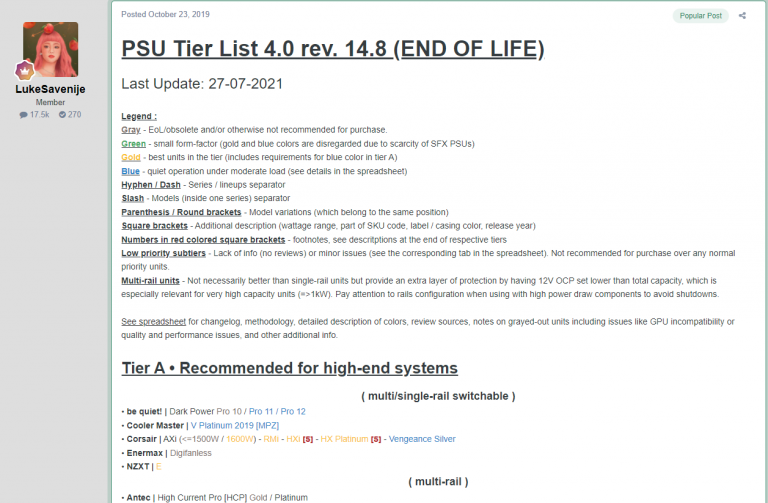
4. Choose from reputable brands.
The wattage delivered from a PSU on its label indicates it's rated power, which doesn't mean the power supplies will reach that wattage over a long period of time. Many manufacturers have played "cheat" by naming the capacity of the PSU based on the peak power (peak), or even with many fake PSUs on the market, the power level on the label is "hanging head". selling dog meat”. This leads to fatal mistakes on the part of users when choosing bad PSUs, because they will think they are owning a high-capacity and cheap PSU. So it's important to avoid noname power supply manufacturers and stick with well-known manufacturers only. Here is a quick list of manufacturers that are known for providing quality PSUs:
- EVGA
- Corsair
- Seasonic
- Super Flower
- Antec
- Cooler Master
- Silverstone
- Thermaltake
- be Quiet!
- Enermax
- Delta
- FSP
- Andyson
- NZXT

Of course, this is by no means a final list and it is important to note that not all power supplies from the manufacturers listed above are quality products. Therefore, it is important that once users choose a product, they should consult and read reviews from experts, quality articles like the section below will talk about.
5. Refer to reviews from experts or reputable websites.
In order to evaluate a good or bad quality PSU, in addition to the electronic experience of experts, it is also necessary to mention the process of testing and measuring from specialized equipment. In Vietnam, there was Powerlab in the past. In-depth review of PSUs in detail and quality. Currently, the replacement for PowerLab (after Mr. SuSu's departure, the unit has now stopped working) is F14 Testlab. In these units there are specialized evaluation devices, from which to analyze the ability of a power supply to be good or bad.

Although F14Testlab's system can best test current mass-market PSUs. However, due to personnel issues as well as the barriers to cooperation with PSU brands, users will rarely see reviews of popular PSU products. Therefore, we are forced to go abroad to find reputable Websites/Testlabs to learn about products, here are a few reputable units:
- JonnyGuru (discontinued, sorry this is an extremely reputable site in the PSU world)
- Tomshardware
- Hardware Secrets
- Hard OCP
- KitGuru
- Guru3D
- AnandTech
- Techpowerup
- Overclock3D
If you speak English, before you buy a certain power supply you should check and see if any of the sites above have done a review on it first. Especially JonnyGuru, a place where many PSU experts gather to provide accurate discussions and assessments.
III. What is performance? And why choose high-performance PSUs?
A technology standard created in 2004 that later became a standard that many PSU manufacturers adhere to is called 80 Plus. This standard is a means of promoting the creation of energy-efficient PSUs on the market for computer systems. In 2005, the first PSUs with 80 Plus certification were released, the reason it was so named was due to its 80% greater energy efficiency.
From the foundation of building 80 Plus certified PSUs, manufacturers have also created PSUs with higher standards and certifications, including: Bronze, Silver, Gold, Platinum, and finally, PSUs. Titanium. The electrical system in the home that users use to connect and provide power is alternating current (AC) while the computer system uses a power supply to convert that power. direct current (DC) used in most electronic devices. There is a problem, when AC electricity is converted to DC – heat is generated.

Now a large part of the power is wasted because of this heat. That's why in reality there won't be any device that converts electricity to 100% unless something groundbreaking is invented by mankind. Thus, the 80 Plus standard simply means that the power supply is qualified to provide 80% of the power level or more at 10, 20, 50 and 100% of its load.
For example, a power supply is 90% efficient. When the PC needs 100W, about 110W (= 100W / 90%) is supplied to the power supply. 10W is then wasted as heat. Likewise, if the power supply is 80% efficient then when the PC needs 100W, about 120W is supplied to the power supply, i.e. 20W is wasted as heat. Therefore, the more efficient the PSU, the better the power savings and lower heat output compared to the low efficiency PSU. Most importantly, the power supply is more efficient using a 230V outlet. Since there is a difference of 2-5%, there is no doubt that the 230V outlet excels at saving electricity.
IV. Capacitors and their importance
Capacitor is an important component in the system, usually the function of the capacitor is to accumulate electrical energy for a certain period of time, or is used as an anti-interference filter for other components (reducing ripple of power in AC power supplies or filter circuits). As above, PSUs are divided into 6 types of PSUs with 6 different performance ratings. The capacitors in the PSU are also classified into 4 different ratings. In which, Japanese capacitors are used a lot due to the highest quality and stability.

Most PSU manufacturers are located in China (low labor cost), so using Japanese capacitors will be expensive because these PSU manufacturers are forced to import from Japan, incur additional shipping time and costs. Of course, there will still be Japanese capacitor manufacturers located in China, but this is not much of a problem.

The Tier 1 category includes the following brands (according to Tomshardware):
- Rubycon
- United Chemi-Con (or Nippon Chemi-Con)
- Nichicon
- Sanyo / Suncon
- Panasonic
- Hitachi
- FPCAP or Functional Polymer (acquired by Nichicon)
- ELNA
- Cornell Dubilier (USA)
- Illinois (Currently owned by Cornell Dubilier)
- Kemet Corporation (USA)
- Vishay (USA)
- EPCOS (TDK, Germany)
- Wurth Elektronik (Germany)
Tier 2 capacitors include the brands below.
Note that this list mainly refers to capacitors of Taiwanese brands (also located in China). Capacitors manufactured by these brands are commonly used in most mid-range PSUs and sometimes even in high-end models, as it strikes a balance between performance and price.
- Taicon (belonging to Nichicon)
- Teapo
- SamXon
- OST
- Toshin Kogyo
- Elite
Tier 3 capacitors include the brands below.
The PSUs using capacitors of the brands below, although not the best ones, are acceptable because it is still better than many other brands, the RMA ratio is also lower and of course the price is also cheaper than the type. 1 and 2.
- Jamicon
- CapXon
Tier 4 capacitors include the brands below.
In general, this type is used by manufacturers to reduce costs, increase competitiveness, and is only used in low-end or mainstream PSUs.
- G-Luxon
- Su'scon
- Lelon
- Ltec
- Jun Fu
- Fuhjyyu
- Evercon
With a good PSU, the secondary is also quite important. At the filter stage for the secondary part is always well designed with many capacitors, coils, resistors, in which filter capacitors are used of famous brands. There is a feature to note in Tier 1 capacitors compared to Tier 2 types that is the life of Tier 2 ranges from 1k to 3k hours, compared to some Japanese capacitors located in Tier 1, the operating level is low. This is lower (Tier 1 capacitors typically range from 2k to 10k hours). However, as mentioned above, the cost of using Japanese or Tier 1 capacitors will push the price of the product to a high level, so it is often used in expensive PSUs with good design.
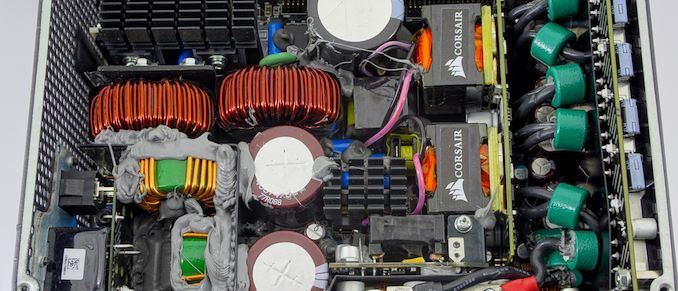
It should be noted that, technically, the use of Tier 1 capacitors does not mean that the PSU is genuine or high-end, because the intrinsic problem is still the platform that makes up that PSU. Not to mention, the operating temperature of the product will greatly affect the life of its own components. That's why many tests have proven, the same PSU has a bad platform, basic components, changing the low tier capacitor to a high tier, the more riple is affected and the quality of course. still can't be a good PSU.
V. How to determine the rated power/rated power of a PSU
Different PSUs with different platform designs and component values will have different power levels. This results in the rated wattage markings also being different based on the design of each type.
In the illustration is Cooler Master's MWE 750 Bronze – V2 product line, people notice the Total Power section marked with its blue circle is 750W. This is the rated wattage of a power supply, or can also be thought of as the rated wattage listed on the label. The rated power of the power supply will be calculated by the total output power (DC Output) of the +12V, +5V and +3.3V, -12V, +5V lines. But one caveat, for a standard power supply, the total wattage of these lines must be greater than or equal to the rated wattage marked on the power supply. If the total wattage of these lines is less than the marked rated wattage, the rated wattage listed on the power supply is incorrect, and that indicates the power supply has a shabby appearance.

According to the above calculation, the total capacity of the power lines of the MWE 750 Bronze - V2 now reaches 888.6W, which is larger than the Total Power 750W that the manufacturer offers. This is completely reasonable for a quality PSU in the mid-range segment like the MWE 750 Bronze – V2.
In the red section on the label of the MWE 750 Bronze – V2 as shown in the picture, some people will wonder why the +12V line of this PSU has a total capacity equal to the rated capacity? While in many other PSUs this number is significantly lower? This is also a very good way to determine part of the quality of the PSU.
In fact, PSUs with +12V lines equal to or close to the rated power are more likely to adopt an advanced DC to DC design. The DC to DC circuit is designed on a separate module, after the +12VDC rectifier diodes. The heavy-duty module lowers the voltage from +12VDC to two lower voltages of +3.3V and 5V, and plays the role of voltage stabilizer for these power lines. In the opinion of many experts and testlabs in the world, using a DC to DC circuit to take power from +12VDC and lower the voltage to the +3.3V and 5V lines is actually more beneficial in improving the performance of the device. power supply and it is more in line with the development trend of PC power supplies for modern computer systems.
BECAUSE. What is a Modular Power Supply?
Currently, there are 3 types of power supplies on the market, which are divided into:
- Direct mounting: the cable is connected directly to the power supply.
- Semi Modular: Main + CPU connection cable is directly connected to the power supply, the remaining cables are removable.
- Full Modular: All cables are removed.
The cable of the PSU is very necessary because in addition to the quality of the cable design, the length of the cable also affects, the reasons are as follows:
- Small case (like Mini-ITX): PSU cables that are too long will be cumbersome and take up space
- Large case (E-ATX, etc.): Short cables make it difficult to wire.
Advice for gamers and professional users, especially workstation systems, should pay attention to the number of PCIe and CPU connectors. For example, a Dual Xeon system needs at least two 8-pin power supplies, for example, or a system running the SLI 2080Ti requires at least four 8-pin power supplies.
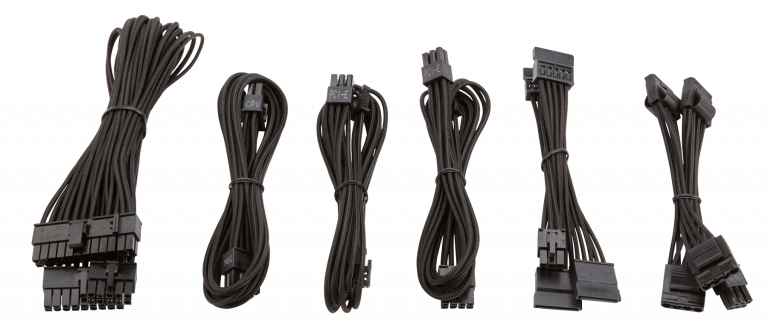
VII. What is a poor quality power supply like?
- Produce only to the old and outdated ATX v1.x standard instead of ATX v2.x.
- The label says it's overrated while the performance only provides about 50-60% of the capacity compared to the label.
- Using a thin wire standard leads to increased load on the wire, heat and causes many unnecessary problems. Currently real power PSUs use the 18AWG standard, but many inexpensive PSUs still use the 20AWG standard.
- Low 12V line, or multiple rails but each rail provides low current.
- The ports are few.
- Poor and outdated components. For example, remove capacitors, inductors or use poor quality capacitors.
- The cooling system comes with poor quality.
- Not fully declared or without protection functions (over voltage, over current, over temperature, etc.)
- No A.PFC or at least a P.PFC.
- No basic or advanced certifications (UL CUL, CB, CCC…)
- No information to consult or content to support online/manufacturer: datasheet, review…
These cheap noname sources but with "extremely high" recording capacity contribute to significantly harming your PC.
VIII. Should software be used to measure the 12V line of the PSU?
Due to 12V measuring software, it reads based on the IO chip and the resistor bridge used on the Main. But each Main has very different quality of IO chip design and resistor bridge, leading to different errors and even inaccuracies. Not to mention that each measurement software reports a different number of 12V lines, so in many cases this soft will report 11V, the other will 10V… So it's best to buy a VOM or DMM, the cheap one, only about 150k, is also quite accurate. The accuracy of the 12V line of the PSU because the error of this type is 0.05. As for a good VOM/DMM with many other features and accurate measurements, the price is usually very expensive, from a few million to more than tens of millions.
Illustrating the use of soft measurement of 3.3, 5 and 12V indicators for reference only:

IX. The source that is being used when turning it on and off all rattles, is it a bad source?
There are many people wondering, that the source is in use but every time the machine is turned off or on, it clicks and then fears that there is a problem or not? The answer is okay and that is a point of identifying good, even genuine, power supplies. Why do you say that? Because technically, the power supply when shutting down or turning on the machine makes a click, that is the sound of the Relay (also known as a relay). This relay supports the NTC thermistor, reducing the inrush current that occurs during the starting phase of the PSU. When a PSU has this relay, the cost increases, but besides the small performance increase, it also allows rapid cooling of the thermistor, thus increasing the protection level of a power supply. Medium, high-end or large-capacity power supplies in big brands we will often see this Relay.

X. What is High Frequency Noise (Ripple)?
Intel's ATX standard requires Rail 12V with ripple level less than 120mV and the remaining rails below 50mV in order not to affect voltage-sensitive components on the PC system.
In addition to the problem of voltage drop due to the 12V line being too low or too high (in the range of +-5%), ripple & noise is an important indicator to evaluate the quality of a PSU. Unfortunately, most users don't care about this. A branded PSU does not necessarily produce a product with this good index. Also, there are a lot of people saying: I use this and that PSU, I don't think it's dead > conclude the PSU is good. However, for a few years of using the computer, they went to warranty from Main / VGA / HDD / SSD and only the PSU did not have to go under warranty. From there they conclude that: some Main brands, some VGA companies, some HDD / SSD companies are all dumb. This is called a mistake in the egg.
Meanwhile, the direct cause is not there, but in the PSU. A PSU with poor quality components will cause voltage drops to occur on the system, or high frequency/AC noise will damage other components in the entire system. An ATX rated PSU is a PSU with ripple & noise below the allowable range: +3.3V, 5V, -5VSB: 50mV; 12V (V1, V2…) : 120mV.
Lines when measuring ripple / noise beyond the permissible level (ie larger than the ATX standard) will be judged as bad, the larger this number, the more obviously computer components are affected. In the long run, if one day you have to go for a warranty on computer components instead of the PSU, it's unlikely that the component will be as jagged as you said! In the illustration below of a PSU, the product ripple is over the limit, up to 132mV, over 120mV for the 12V line.

XI. What is Cable Type 4?
When Jonnyguru reviewed the product Corsair RM750i, the ripple index after full load testing of the product was only 11mV, a very good level. Or Techpowerup when reviewing Corsair RM1000i also found that the ripple index of the product is 17.5mV, which is much better than similar products and far exceeds the product's minimum regulation for ripple on lines. The reason for this, if you notice, in some of the reviews that F14Testlab mentioned, about some PSU lines with very low ripple. The simple secret in addition to the PSU is designed on a good platform, quality components, the common point of these products is that the manufacturer has used a new cable, called Type 4. So the point What is the difference of this Type 4 compared to others?

That is, using small, solid capacitors on the +12V, +5V and +3.3V leads or on the 24-pin, PCIe and EPS12V cables. According to Corsair, they used these Type 4 cables for the PSU. brand new and high end, to achieve the best ripple. For example, the HX1000i has the same technology and components as the RM1000i, but the ripple is higher, just because it doesn't use this Type 4 cable.
In addition, the difference of this Type 4 cable compared to Type 3 and other cables. That is, there is a total of 28pin with the cable plugged into the PSU's module, which means an additional 4pin instead of the usual 24pin. These 4 additional pins are termed “sense wire”. Thanks to these additional “sense wires” at the +12V and +5V lines, the PSU can read the load voltage at the top of the cable, and even if it senses a voltage drop, it will automatically increase the voltage level. PSUs Using this innovative cable resulted in better ripple levels compared to similar products and best performance to users.
Details of the latest Type 4 Corsair PSUs can be found at: https://www.corsair.com/us/en/psu-cable-compatibility
XII. Is the 80 Plus standard still relevant in practice with standard PSUs?
Germany's Igorslab 1 year ago did an "investigation" report on the price increase of power supplies in 2021 of some PSU manufacturers, and pointed out the problem of 80 Plus standard certification on power supplies. The source is useless if these products have not been tested in the field. The 80 Plus standard was first introduced in 2004 by Ecos Consulting. Originally this 80 Plus standard was a program for certifying the energy efficiency of PSUs – so-called performance for short, with a focus on “voluntary” – no one really forced manufacturers or brands to certified their PSU to the 80 Plus standard.
After 16 years of existence and development, the 80 Plus standard still has some disadvantages that make it no longer a single standard for power efficiency for power supplies. One of the main disadvantages of the 80 PLUS program can be mentioned as:
- Limited number of measurements.
- Ambient temperature was very low during the test.
- No control over 5VSB measurements.
- No control over performance certification badges on products.
- No mention of devices used.
- No control over certified products and final products released.
That's why there was a voluntary program called Cybernetics, which is a modern program designed to create newer standards. Compared to the existing program, the voluntary certification program offered by Cybenetics aims to increase accuracy in certifying the performance of power supplies, solving the disadvantages of the 80 Plus standard. Also provides authentic verification of the operating noise level of the PSU.
Cybenetics also provides evaluation and beta testing reports of PSUs to help save significant time and money in the process of increasing the quality and performance of tested products. Cybernetics introduces a new performance benchmark assessment called ETA based on a sophisticated methodology that takes into account many factors. In contrast to 80 PLUS which only tests at three or four different load points, ETA combines load points when using a single, custom application to calculate the performance results of thousands of different load combinations, through through a proprietary app. This process allows Cybernetics to use a single value rating to represent the true overall performance of the PSU. Furthermore, and very importantly, Power Factor, Vampire Power and the performance of the +5VSB line are also considered in the final rating.
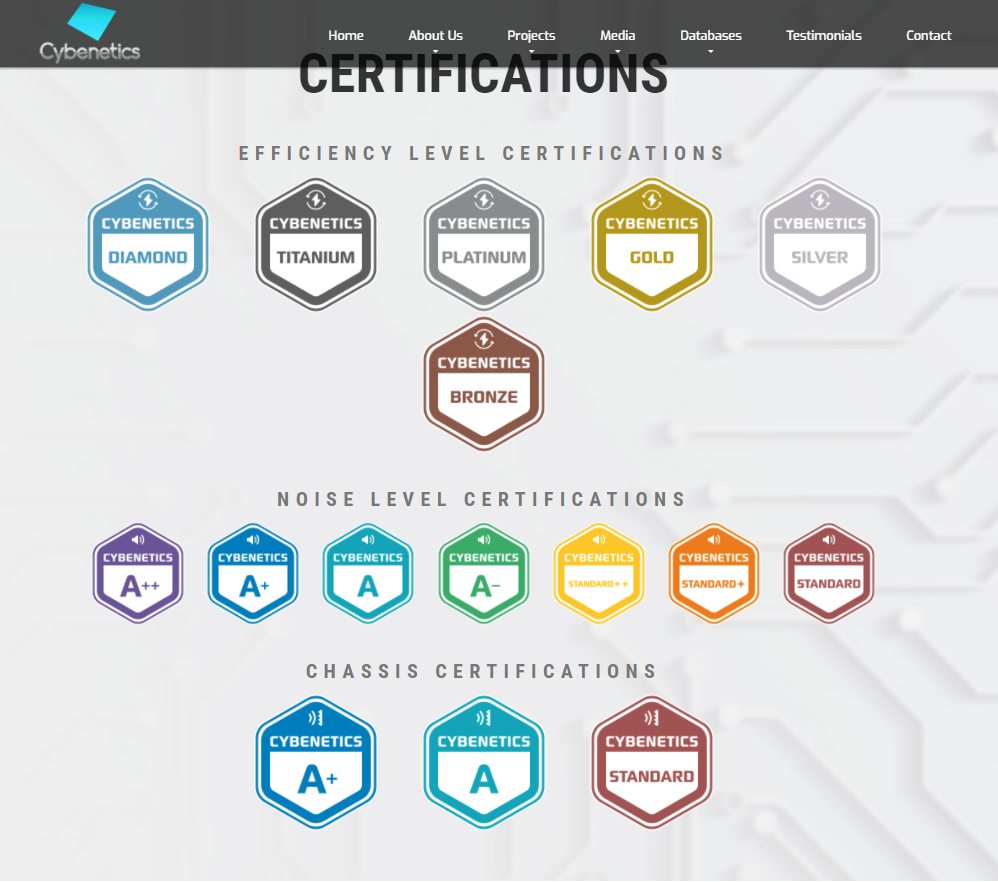
Cybenetics also offers a certified PSU in use noise standard called LAMBDA. Using an advanced method and a very sophisticated control/monitoring program, the noise readings of the power supply are recorded throughout its entire operating range. These readings are then converted to sound pressure levels (SPL), averaged, and converted back to dB(A) again.
The current ETA certification includes 6 levels from Bronze to Diamond, while LAMBDA includes seven levels, as the illustration of the article shows. Previously, when it was first established, seven levels of noise included (A ++, A +, A, B, C, D and E), but now Cybenetics has been replaced with levels A++, A+, A, A-, S++, S+ and S.
Each manufacturer or brand can choose to use one of two corresponding certification badges that describe the level of achievement, or a more comprehensive badge that covers overall performance or noise levels. In addition, each badge will be associated with the specific product via a short URL and QR code, which will be printed on the badge. This will allow users to easily find the evaluation report of the Cybernetics-certified PSU.
For more details, people can visit the Cybenetics homepage to find out: https://www.cybenetics.com/

